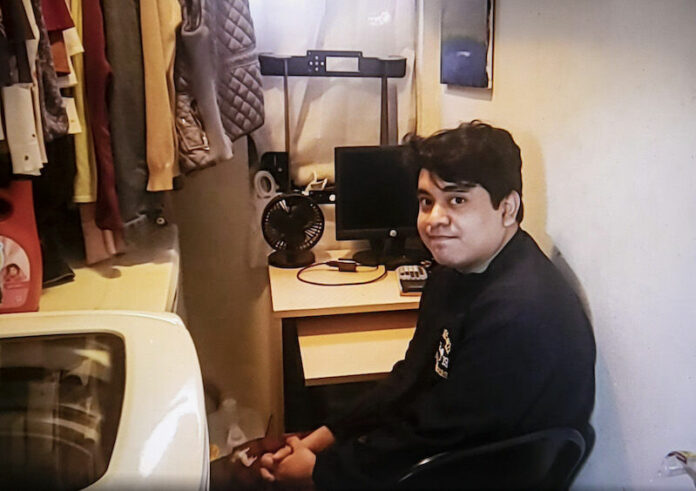
Study spaces: In a typical school year, they’re everywhere. College students can hit the books in their dorm rooms, head to the library or settle in at a local coffee shop.
But this past year has been anything but typical, as many students packed into homes with working parents, Zoom-studying siblings and sometimes children of their own. The cramped study environments can pose an academic disadvantage to low-income students who are more likely to live in crowded conditions, said Daniel Stokols, a professor emeritus of social ecology at University of California, Irvine.
“When you have a certain amount of affluence and space at home, when you’re not as confined… you’re going to be at an advantage going forward (compared to) people who are trying to focus on a class on Zoom and they’re being distracted by the noise around or the high density or lack of access to nature.”
Stokols studies the relationships between people and their environments, from the micro level (individuals and families) to the macro level (neighborhoods and national or global policies), and the way those relationships affect behavior. He wrote an essay on the loss during the pandemic of so-called “second and third spaces” — places outside the home that offer respite and a chance to interact with other humans.
The CalMatters College Journalism Network recently spoke with Stokols and students who are making the best of awkward study spaces, to understand how the pandemic is affecting learning environments. Natural light, ventilation, defined territory and personalization, and fewer people per square foot can all make a space conducive to learning, Stokols said. But in a raging pandemic, those may be harder to come by. Here are the biggest takeaways from our conversations
-
Laundry rooms and bedrooms have replaced libraries
Abel Guillen has his own dedicated study space to finish his mechanical engineering homework — except when his family has to do the laundry.
When distance learning began last March, Guillen, a second-year student at California State University Los Angeles, moved into the tiny one-bedroom house that his parents share with his sister in South Los Angeles
He put together a makeshift office in the home’s 5’ by 5’ laundry room: a sawed-down-to-size yellow desk with a small window providing a glint of natural light. He spends hours a day sandwiched between the washing machine and a wall on his metal folding chair, attending classes and working on assignments.
“It’s always a little bit cramped in there,” Guillen said, “but…it’s kind of the best way for me to actually do all my stuff at my pace.”
A crowded space may not be a productive one. Researchers have been studying the effects of crowding on college students for decades, Stokols said. Take, for example, this study done in the 1970’s that shows dormitory students in crowded dorms may withdraw from social interactions. More recent studies show that students in crowded settings can develop depression, anxiety and unhealthy coping habits such as binge eating and overuse of the internet.
Before the pandemic, Guillen lived on campus and studied at the library. Downsizing to the laundry room is stressful, he said, but it’s all his family can afford at the moment. His parents, both immigrants from El Salvador, worked hard to get where they are, and Guillen hopes he can find success in life by going to college. But he said recently, he’s struggled with some classes, and developed “a slight fear of failing.”
“It’s tough,” Guillen said. “I just gotta figure out a way to just pull through and pass.”
-
It’s hard to drown out a house full of people
Some people can work well in loud environments and others have more trouble, Stokols said. But people who live in crowded homes or neighborhoods may not have the option to adjust the noise levels in their study spaces. And with multiple people at home all doing their own thing, the noise can add up.
“If you can’t control that, you can’t regulate that, that’s going to be problematic, if that’s chronic, if it’s something that you’re dealing with on a day to day basis,” Stokols said.
The sounds of home permeate Guillen’s Zoom classes, he said: comments from his “chatty” older sister who is looking for a job, voices from the television, his tiny white chihuahua’s yipping. Guillen learned early on to use the Zoom unmute function with extreme caution during the day, especially when his dad is watching soccer.
“I was doing all my notes for math, and I was gonna ask my professor a question. I turn on my mic and then my dad…his team didn’t win,” Guillen said. His dad yelled an expletive in Spanish, which to Guillen’s chagrin was heard by his entire class.
Julian Zavala, a former radiology student at Long Beach City College, said the stress of studying in a shared room, in a house with seven people, contributed to his decision to drop out of school.
“There’s so much going on around me that it’s hard to pay attention to my classes,” Zavala said. “It’s just all the background noise that comes with being at home.”
The disruptions caused Zavala to lose motivation, he said.
“‘I don’t really want to do this, I’m tired, I’m not in the mood to do it right now,’ and then after a while it kind of just takes over and then you don’t really want to do any of your work,” Zavala said.
-
Some students are finding ways to personalize their spaces
Above Guillen’s desk hangs a painting he made of a sunset over the ocean. The way the red, orange and blue hues blend together chaotically reminds Guillen of this year, so he has named the piece “2020.”
It’s the closest Guillen gets to personal space in the house. He shares the single bedroom with his sister, while his parents sleep on a futon in the hybrid living room, kitchen and dining room.
But even those small efforts to personalize Guillen’s quasi-private sanctuary might make a difference, Stokols said.
“This is really important in workspaces,” Stokols said. “Being able to maintain your own territory — people seem to have a need for that.”
-
Without a desk and chair, school work can be backbreaking work
Unlike Guillen, Nancy Saucedo lives in a three-bedroom home and has her own space to study in. But there’s a problem: the University of California Davis history student’s room is so small that she has no space for a desk and chair.
That means lots of late nights slumped on her full-sized bed doing school work. It’s the best way to avoid being distracted by the rest of her family, and often the only time she has left after tutoring her eight-year-old sister.
Saucedo moved back in with her family in Porterville after the pandemic made it difficult for her to afford her Davis apartment and her parents needed someone to watch her sister, who is also doing school online. Her parents, both field workers, spend 10-12 hours a day harvesting lemons and oranges.
The bed isn’t the most comfortable place to work, and it’s an example of the kind of ergonomic stress that Stokols says can distract students from their work. Saucedo says she builds pillow forts around herself for more back support, but can only take the slouching for so long. If she had a proper desk, she figures, she’d have been able to focus better in the fall.
“Luckily I was able to pass. It wasn’t with the grades that I normally get,” Saucedo said. “But at that point I was just like ‘I passed. C’s get degrees. We’re done. Let’s go to sleep.’ ”
-
The loss of alternate spaces has deeply affected students
As many students have returned to live with family, traditional boundaries between home, work and school have blurred.
Ana Garcia, a human development student at UC Davis, used to spend her study time in libraries next to large windows, which helped with her depression. Now, her home and school spaces are one and the same — and, she says, her fall quarter grades suffered.
“Studying at school or the library, I would get into the mindset of ‘Okay, here I am. I’m studying,” Garcia said. “Then at home, if I just wanted to do nothing, that was my place. Now I feel like that’s gone.”
Academic stress during the pandemic has been intensified by the loss of what sociologist Ray Oldenburg called second spaces — offices and schools — and third spaces like coffee shops, book stores and public libraries, Stokols said. First spaces (homes) are becoming hybrid second and third spaces where students may be dealing with multiple stressors at the same time — work, family members, kids and school. “It can be a real pressure cooker,” Stokols said.
Over the years, technology has made the distinctions between different types of spaces somewhat arbitrary, Stokols said. Now you can work from home and meet with friends online. But the pandemic, he said, has revealed that people still rely on spaces outside the home.
“When people spend hours on Zoom each day, in these long meetings or classes, they get fatigued, they can’t be creative….It’s a very kind of disembodied way of interacting with people,” Stokols said.
Some colleges have strengthened Wi-Fi in parking garages, creating makeshift study spaces for students who lack internet access at home. But studying in a car can be cramped and noisy.
The loss of alternate spaces weighs especially heavily on homeless students, who usually do not have a stable place to accomplish schoolwork, said Pixie Pearl, director of the California Homelessness Youth Project.
Surveys show that 17% of college students nationwide experienced homelessness in 2018-2019. The pandemic has closed many libraries, long havens for homeless people to find resources and shelter.
“Shelters are overcrowded now and then and they’ve also decreased their capacity to be able to maintain COVID-safe practices,” Pearl said.
Unstable living conditions increase the likelihood of homeless college students experiencing mental health issues that can affect their academics, Pearl said, creating a vicious cycle.
“If your worth is based on how well you’re doing in school— because it’s the only identity you have beyond being homeless—and then that’s not going well, it doesn’t give you any other sight into yourself.”
-
Lap desks and headphones can help, but the real solutions are systemic
Saucedo bought a lap desk for her bed to help with slouching, and uses headphones to drown out noise from home. Guillen listens to the theme music from the anime series Naruto while studying.
Stokols said those coping mechanisms can make a difference, but at some point schools and governments have to take the lead in providing solutions — such as more access to green space where students can find fresh air and an escape from the stress of home.
That’s worked for Garcia, who lives in Davis near several parks and said that going on walks has helped her relax more than if she didn’t have that outlet. Such access is heavily dependent on income and education, however, studies show.
“Because people have such an essential, strong contact with nature, that can be a disadvantage for people in neighborhood structures that don’t have that amenity,” Stokols said.
Even with classes still largely online, some colleges have opened up their campus grounds for students to work on assignments while socially distanced. UCLA is reopening the campus research library, practice and rehearsal rooms, and recreation centers. Other schools have been providing more in-person classes, including outdoors, as they plan to bring at least some students back to campus in the fall.
Cuyamaca College, a community college in El Cajon, has 20’ by 20’ tents set up in the parking lot where students can use Wi-Fi and study for classes. A grassy lawn was also used for studying before it became a vaccine distribution center. At a time when community college enrollment has dropped statewide, the college saw no decrease in enrollment last semester, which the college’s president, Julianna Barnes, attributed partly to the opportunities available on a campus with a lot of land. The outdoor study spaces were especially attractive for rural students whose internet access is spotty, campus officials said.
UC San Diego has opened outdoor classrooms and study spaces as part of its Return to Learn program. The three al fresco study halls accommodate up to 35 students for labs and group work on a first-come, first-served basis, with social distancing and mandatory masking.
“If we don’t have those higher level solutions,” Stokols said, “then doing a few things around the edges at home, they’re more like Band-Aid solutions.”
Getahun is a former fellow with the CalMatters College Journalism Network, a collaboration between CalMatters and student journalists from across California. Tess Kazenoff contributed reporting. This story and other higher education coverage are supported by the College Futures Foundation.
Sonoma West Publishers is partnering with CalMatters to provide a wider variety of news that gives our readers national and regional context for issues facing our local communities.








